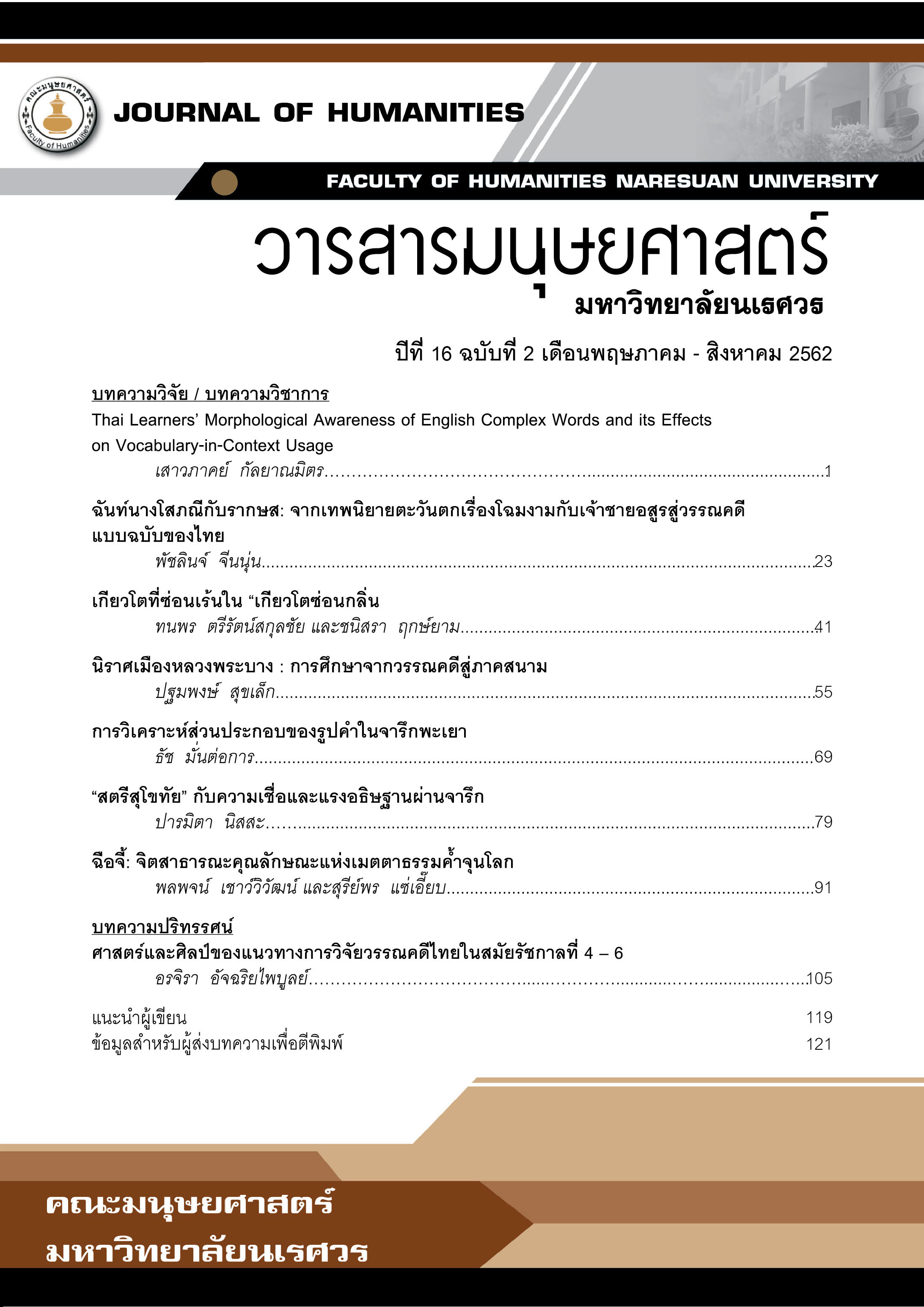การตระหนักรู้เรื่องหน่วยคำของคำผสานในภาษาอังกฤษของผู้เรียนชาวไทย และผลของการตระหนักรู้ที่มีต่อการเลือกใช้คำศัพท์ในบริบทต่างๆ
Main Article Content
บทคัดย่อ
งานวิจัยนี้ศึกษาการตระหนักรู้เรื่องหน่วยคำของคำผสานในภาษาอังกฤษของผู้เรียนชาวไทยจำนวน 53 คน และผลของการตระหนักรู้ดังกล่าวต่อการใช้คำศัพท์ในบริบท แบบทดสอบปรนัยมี 4 ฉบับ โดยมีคำผสานที่มีหน่วยคำสองถึงห้าหน่วยและมีทั้งรากศัพท์อิสระและไม่อิสระ รวมทั้งอุปสรรค (prefix) และปัจจัย (suffix) ที่เลือกประเภทของคำบางชนิดในการเชื่อมต่อกับรากศัพท์ พบว่าการเพิ่มจำนวนหน่วยคำและรากศัพท์ชนิดไม่อิสระไม่มีผลกระทบต่อระดับการตระหนักรู้เรื่องหน่วยคำ ไม่พบความสัมพันธ์ระหว่างการตระหนักรู้ด้านโครงสร้างและความหมายของหน่วยคำ การตระหนักรู้เรื่องข้อบังคับการเลือกใช้ชนิดของคำพบในอุปสรรคและปัจจัยบางตัวเท่านั้น และเฉพาะการตระหนักรู้เรื่องความหมายของหน่วยคำมีผลดีต่อการใช้คำศัพท์ในบริบท ไม่พบอิทธิพลของภาษาที่หนึ่ง แต่พบผลกระทบของรูปที่ไม่ปกติของปัจจัยและความกำกวมของอุปสรรคและปัจจัย ที่มีต่อการตระหนักรู้เรื่องหน่วยคำ
Article Details
ข้อความรู้ใด ๆ ตลอดจนข้อคิดเห็นใด ๆ เป็นของผู้เขียนแต่ละท่านโดยเฉพาะ คณะมนุษยศาสตร์ มหาวิทยาลัยนเรศวร และกองบรรณาธิการวารสารมนุษยศาสตร์ฯ ไม่จำเป็นต้องเห็นพ้องด้วย
เอกสารอ้างอิง
Akbulut, F. D. (2017). Effects of morphological awareness on second language vocabulary knowledge. Journal of Language and Linguistic Studies, 13(1), 10-26.
Carstairs-McCarthy, A. (2010). An introduction to English morphology: Words and their structure. Edinburgh: Edinburgh University Press.
Deng, T., Shi, J., Dunlap, S., Bi, H., & Chen, B. (2016). Morphological knowledge affects processing of L2 derivational morphology: An event-related potential study. Journal of Neurolinguistics, 37, 47-57.
Dyson, B. (2009). Processability theory and the role of morphology in English as a second language development: A longitudinal study. Second Language Research, 25(3), 355-376.
Ellis, R. (2002). The study of second language acquisition (9th ed.).Oxford: Oxford University Press.
Evans, J. D. (1996). Straightforward statistics for the behavioral sciences. Pacific Grove, CA: Brooks/Cole Publishing.
Flanigan, K., Templeton, S., & Hayes, L. (2012). What’s in a word? Using content vocabulary to generate growth in general academic vocabulary knowledge. Journal of Adolescent & Adult Literacy, 56(2), 132-140.
Fromkin, V., Rodman, R., & Hyams, N. (2017). An introduction to language. MA: Boston.
Gass, S. M.andSelinker, L. (1994). Second language acquisition: An introductory course. New Jersey: Lawrence Erlbaum Associates.
Hashemi, M., & Aziznezhad, M. (2011). Etymology: A word attack strategy for learning the English vocabulary. Social and Behavioral Sciences, 28, 102-106.
Haspelmath, M. & Sims, A. D. (2010). Understanding morphology (2nd ed.). London: Routledge. Hinton, P.R., Brownlow, C., McMurray, I., & Cozens, M. (2004). SPSS explained. London: Routledge
Iwasaki, S. & Ingkaphirom, P. (2005). A reference grammar of Thai. New York: Cambridge University Press.
Jeon, E. H. (2011). Contribution of morphological awareness to second-language reading comprehension. The Modern Language Journal, 95, ii, 217-236.
Karlsson, M. (2015). Advanced students’ L1 (Swedish) and L2 (English) mastery of suffixation. International Journal of English Studies, 15(1), 23-49.
Kraut, R. (2015). The relationship between morphological awareness and morphological decomposition among English language learners. Read Writ, 28, 873-890.
Lardiere, D. (2006). Words and their parts. In R. Fasold & J. Conner-Linton (Eds.), An introduction to language and linguistics (pp.55-96). Cambridge: Cambridge University Press.
Li, M. (2017). The effect of L1 Chinese transfer on L2 English learning: A brief review of the research. Theory and Practice in Language Studies, 7(5), 350-355.
Lieber, R. (2010). Introducing morphology. Cambridge: Cambridge University Press.
Masrai, A. M. (2016). The influence of morphological knowledge on lexical processing and acquisition: The case of Arab EFL learners. Ampersand, 3, 52-60.
Mochizuki, M., & Aizawa, K. (2000). An affix acquisition order for EFL learners: An exploratory study. System, 28, 291-304.
Oz, H. (2014). Morphological awareness and some implications for English language teaching. Social and Behavioral Sciences, 136, 98-103.
Paiman, N., Thai, Y. N., & Yuit, C. M. (2015). Effectiveness of morphemic analysis of Graeco-Latin word parts as a vocabulary learning strategy among ESL learners. 3L: The Southeast Asian Journal of English Language Studies, 21(2), 31-45.
Saville-Troike, M. (2004). Introducing second language acquisition (3rded.). New York: Cambridge University Press.
Solati, A. (2014). Word-formation: A systematic way to enrich power of medical students. Modern Journal of Language Teaching Methods, 4(1), 20-33.
Tahaineh, Y. (2012). The awareness of the English word-formation mechanisms is a necessity to make an autonomous L2 learner in EFL context. Journal of Language Teaching and Research, 3(6), 1105-1113.
Ward, J., & Chuenjundaeng, J. (2009). Suffix knowledge: Acquisition and applications. System, 37, 461-469.
Zhang, D., & Koda, K. (2012). Contribution of morphological awareness and lexical inferencing ability to L2 vocabulary knowledge and reading comprehension among advanced EFL learners: testing direct and indirect effects. Read Writ, 25, 1195-1216.
Zhang, D., & Koda, K. (2013). Morphological awareness and reading comprehension in a foreign language: A study of young Chinese EFL learners. System, 41, 901-913.
Zhang, D., Koda, K., & Sun, X. (2014). Morphological awareness in biliteracy acquisition: A study of young Chinese EFL readers. International Journal of Bilingualism, 18(6), 570-585.
Zhang, Y. & Widyastuti, I. (2010). Acquisition of L2 English Morphology: A family case study. Australian Review of Applied Linguistics, 33(3), 29.1-29.17.


